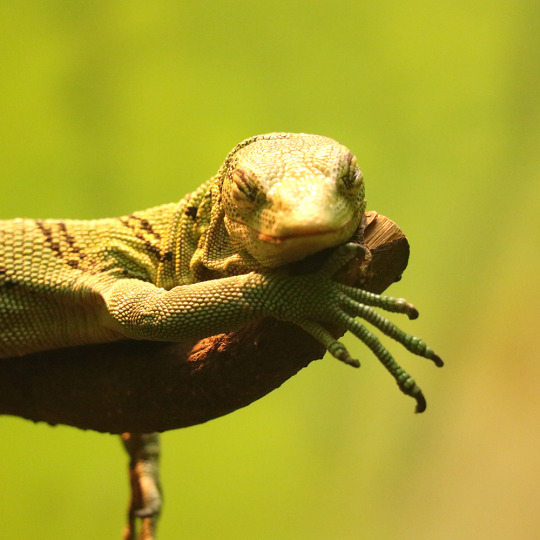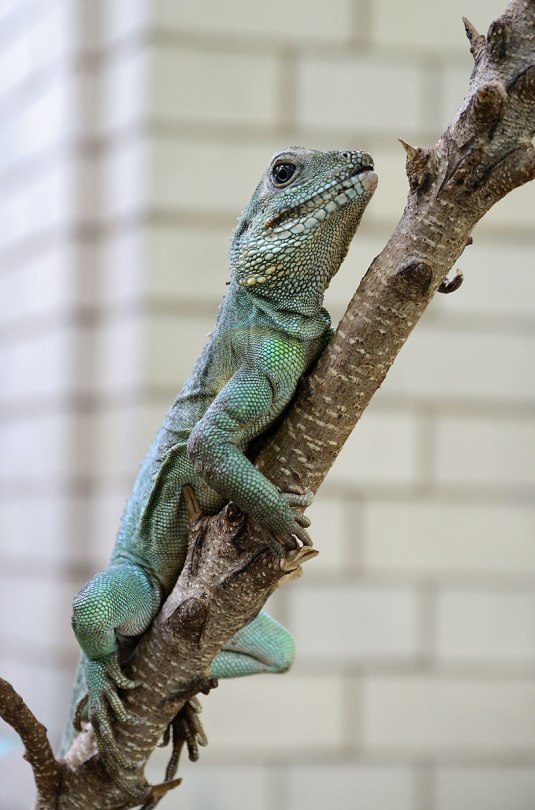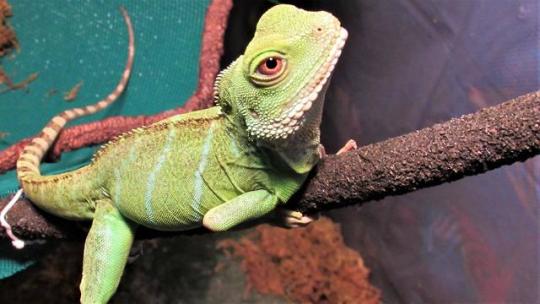#physignathus
Text

Chinese Water Dragon (Physignathus cocincinus), male, family Agamidae, Khao Yai National Park, Thailand
Photograph by Rushenb
165 notes
·
View notes
Photo

すてきな掌
@日本平動物園
11 notes
·
View notes
Text
恭喜发财! It's the year of the dragon, which is great news for the Chinese water dragon. Adults can be quite large, reaching up to 90 cm (3 feet) in length, and as their name implies they are adept swimmers and can spend up to 25 minutes underwater!

(Image: A Chinese water dragon (Physignathus cocincinus) by Paul McKenzie via iNaturalist)
If you like what I do, consider leaving a tip or buying me a kofi!
#chinese water dragon#Squamata#Agamidae#dragon lizards#lizards#squamates#reptiles#uncharismatic facts
204 notes
·
View notes
Text


Chinese water dragon (Physignathus cocincinus)
these guys are so sweet <3
#ask#reptilia#reptile#this was just a baby guy#they are pretty chill about being handled#and so pretty
57 notes
·
View notes
Text

©photography by Walter Jenkel 2023 Chinese water dragon (Physignathus cocincinus) WALTER JENKEL @WalterJenkel 🌊🐉
35 notes
·
View notes
Text
Wildlife trade threatening unprotected animal
New Post has been published on https://petnews2day.com/pet-industry-news/pet-travel-news/wildlife-trade-threatening-unprotected-animal/
Wildlife trade threatening unprotected animal


image: The red-eyed crocodile skink (Tribolonotus gracilis) is endemic to New Guinea. Trade is only recorded by the US and EU, with recent import numbers indicating local wild harvest quotas are likely being exceeded by exporters.
view more
Credit: Adam Toomes, the University of Adelaide.
International trade in animals not regulated by multilateral agreements is putting them under increasing threat. More than three times the number of unregulated animal species are being imported into the United States compared to the number of regulated species. Closer monitoring of trade in these species is urgently required so that they may be protected.
University of Adelaide researchers have looked at the number of species not listed under the Convention on International Trade in Endangered Species of Wild Fauna and Flora (CITES) that are entering the United States.
Ms Freyja Watters, who led the study, is a Ph.D. candidate from the University of Adelaide’s Invasion Science and Wildlife Ecology Group in the School of Biological Sciences.
“The international wildlife trade is currently one of the leading threats to global biodiversity conservation and environmental security,” she says.
“The global trade in live terrestrial vertebrates, mainly for pets, is increasing, and we found a growing demand for unregulated and novel species entering the United States, which is the largest global importer of wild species for the exotic pet market.
“Using a decade of importation data on wild harvested, live animals entering the United States, we found 3.6 times the number of unlisted species in U.S. imports compared with CITES-listed species (1,366 versus 378 species).”
Of the 1,366 species of amphibians, birds, mammals and reptiles not listed in the CITES appendices which were imported into the United States, these included species at risk of extinction, yet traded in large numbers, such as the golden gecko (Gekko badenii) and Chinese water dragon (Physignathus cocincinus), or species with small and fragmented geographic ranges (<5000km) like Helens flying tree frog (Rhacophorus helenae) and the Chapa Bug-eyed frog (Theloderma bicolor).
Trade in species not currently listed as threatened by extinction may also be cause for concern when numbers traded are increasing through time as was seen in the two-toed sloth (Choloepus didactylus) or when species are regularly imported despite being a known high invasion risk like the Rose-ringed parakeet (Psittacula krameria).
CITES is the largest body regulating the international wildlife trade and exists to ensure the sustainable and traceable legal international trade in wild species.
“Overall, the quantities of live animals entering the United States were approximately 11 times larger for imports of unlisted species relative to imports of CITES-listed species and over a quarter of unlisted species faced current conversation threats,” says Ms Watters.
“Many more species are threatened by trade than are being afforded international protection.”
The research published in the journal Conservation Biology comes ahead of the next CITES Conference of Parties in November 2022.
CITES currently lists in its appendices 10.5 per cent of all described terrestrial vertebrates. No international regulatory framework exists to monitor the trade of species not listed in the appendices.
Proposals to add new species to the CITES appendices are put forward by the governments of participating countries (currently 184) at the Conference of the Parties, held every 2-3 years, but many countries do not record or closely monitor their imports and exports for species not listed in CITES.
“This investigation into imports of unlisted species into the US illustrates why there is an urgent need for monitoring the trade of all species present in the international legal wildlife, not just those listed in the CITES appendices,” says Dr Phill Cassey from the School of Biological Sciences, The University of Adelaide.
“No systematic alert or standard procedure exists to identify when a species may require CITES listing and it is only after the documentation of major declines in wild populations or large volumes of illegal trade seizures that many species are identified as at risk from trade.”
Journal
Conservation Biology
Method of Research
Data/statistical analysis
Subject of Research
Animals
Article Title
The U.S. market for imported wildlife not listed in the CITES multilateral treaty
Article Publication Date
4-Aug-2022
Disclaimer: AAAS and EurekAlert! are not responsible for the accuracy of news releases posted to EurekAlert! by contributing institutions or for the use of any information through the EurekAlert system.
0 notes
Photo

#1mafotopordia #ensina "O Dragão-d'água (Dragão-d'água-chinês) é uma espécie de reptil #squamata da família dos #agamídeos que ocorre no sudeste da #asia e no Sul da #china . Ela se encontra em #florestas tropicais próximas a corpos d'água.O Dragão d'água pertence a família Agamidae (que inclui os #lagarto de chifres e os lagartos agamas) pertencente ao gênero #physignathus ". Lindinho não?! :3 . . . . . . #foto registrada no @butantanoficial . . . #biologia #bio #naturephotography #umafotopordia #folowphoto #canonphoto #cienciasbiologicas #art #fotografiaanimal #animalesfantásticos #animales #escamas #animaisverde #dragaodagua #dragaochines #reptil #brasil🇧🇷 #saopaulocity #institutobutantan #wordphotography (em Instituto Butantan) https://www.instagram.com/p/B-QoerKFp4b/?igshid=1hsyzc5x434qg
#1mafotopordia#ensina#squamata#agamídeos#asia#china#florestas#lagarto#physignathus#foto#biologia#bio#naturephotography#umafotopordia#folowphoto#canonphoto#cienciasbiologicas#art#fotografiaanimal#animalesfantásticos#animales#escamas#animaisverde#dragaodagua#dragaochines#reptil#brasil🇧🇷#saopaulocity#institutobutantan#wordphotography
1 note
·
View note
Photo



Chinese water dragon (Physignathus cocincinus)
The Chinese water dragon is a species of agamid lizard native to China and mainland Southeast Asia. Chinese water dragons can grow up to 1 m in total length, including tail, and can live from 10 to 15 years. Coloration ranges from dark to light green, or sometimes purple with an orange stomach. Like many other reptiles the Chinese water dragon possesses a small, iridescent, photosensitive spot between their eyes referred to as the pineal eye (or parietal eye, or colloquially as the third eye) that is thought to help thermoregulate their bodies by sensing differences in light to assist with basking and seeking shelter after sunset. Since it recognizes differences in light, the parietal eye can also help the lizard avoid predation from birds and other aerial threats, and can awaken from deep sleep from even slight changes in light from overhead.Native to the lowland and highland forests of southern China and southeastern Asia (Thailand, Vietnam, Laos, Cambodia and Burma), Chinese water dragons are most commonly found along the banks of freshwater lakes and streams. They are active during the day (diurnal), and spend most of their time in the trees or plants (arboreal). If threatened, the dragon will drop from the trees into the water and either swim to safety or remain submerged for up to 90 minutes. Though they will also eat vegetation, the diet of the water dragon consists mainly of insects, supplemented with an occasional small fish, mammal or reptile.
photo credits: Marcel Burkhard, Rushenb, Alvesgaspar
#Chinese water dragon#Physignathus cocincinus#lizard#zoology#biology#biodiversity#science#wildlife#nature#animals#cool critters
143 notes
·
View notes
Text

Chinese Water Dragon
Physignathus cocincinus
Source: Here
132 notes
·
View notes
Photo

This is Ziggy, she is a Chinese Water Dragon (Physignathus cocincinus) Chinese Water Dragons, or Asian Water Dragons are part of the agamid lizard family. They can be found throughout mainland Southeast Asia and China, though Ziggy was born in captivity. We purchased her in December of 2017 from a local breeder. She was tiny when we first got her (around 10 inches from nose to tail.) but now measures at around 2 feet long from nose to tail. Their length is made up of about 1/3 body and 2/3 tail. That’s a lot of tail! Though nowhere near as large or strong as an iguana, they can and will tail whip if frightened. Ziggy is pretty mellow, for a Water Dragon. She tolerates handling very well, and loves to roam around our “reptile proof” room that we have her enclosure in. She has a somewhat fickle personality though, the closest I can come to describing it is cat-like. Everything has to be on her terms. Though not considered large in comparison to some other species (iguana, monitor, tegu ect.) they still require plenty of space, especially to climb and swim. Water Dragons love to climb, almost more than they like to swim. Lots of branches, vines and plants are a must. Due to their love of climbing they also have some pretty sharp nails, that unfortunately are NOT retractable. Wearing long sleeves when these lizards get bigger is a good idea to protect your skin. These guys like it humid as well, so open air cages are not recommended unless you rig up a water resistant/mold resistant cover for the outside, and have a fogger/humidifier set up. All in all I consider keeping Water Dragons to be very rewarding. I love their personalities and how “prehistoric” they look. I would not recommend them for beginner keepers, you should have some experience before considering one of these lizards. Also always do your research, and remember that most reptiles live longer than your average cat or dog. (15-20 Years for Water Dragons)
2 notes
·
View notes
Photo

AUSTRALIAN WATER DRAGON
(Physignathus Lesueurii)
MANLY BEACH - AUSTRALIA
April 2015
1 note
·
View note
Photo

Jade starting to warm up to me rather then a neurotic flurry of flailing and scratching me in an attempt to run. #lizardgoals #chinesewaterdragon #thaiwaterdragon #lizardsofinstagram #Physignathuscocincinus #Physignathus #reptiles #herpetology #chill #lizard
#reptiles#lizard#physignathuscocincinus#lizardgoals#chill#physignathus#chinesewaterdragon#thaiwaterdragon#lizardsofinstagram#herpetology
0 notes
Photo

Chinese Water Dragon
Physignathus cocincinus
#chinese water dragon#water dragon#reptiles#reptile#herps#herp#herpetology#scales#green#wildlife#nature#animals#animal#wildlife photography#lizard#agamids#agamidae#reptilia#squamata
19 notes
·
View notes
Text

©photography by Walter Jenkel 2023 👑 Chinese water dragon (Physignathus cocincinus) 长鬣蜥 🐉 WALTER JENKEL @WalterJenkel
长鬣蜥(学名:Physignathus cocincinus)为鬣蜥科髭蜥亚科唯一分佈在大洋洲以外的物種,俗名大马鬃蛇,宠物行业按英语俗名直译为“綠水龍”或“中國水龍”(西方人认为这种鬣蜥长得像西洋龙)。分布于越南、泰国以及中国大陆的广东、广西、云南等地,主要栖息于热带或亚热带海拔100米左右平坝区、常见于有林木、岩石的河流及水沟边以及荫凉的石缝或竹、木上。在台灣,有業者引進做為寵物販售,但有飼主棄養。2013年時,新北市新店區山區捕捉到200多隻长鬣蜥,顯示牠們已造成生態問題
#穿搭#时尚摄影#时尚大片#杂志大片#时尚杂志#商业摄影#审美#审美积累#审美提升#提升审美#月刊#每日审美分享#时尚杂志大片#杂志写真#创意#创意摄影#艺术#尝试一个新look#art#photography#walterjenkel
13 notes
·
View notes
Note
Care for a baby Chinese water dragon?
Chinese water dragons (Physignathus cocincinus) can be pretty easily stressed, so a good environment is especially critical for them. Always, always get a captive bred animal.
You’ll need
20 gallon long enclosure (with mesh lid)
24″ Flurorescent UVB bulb+fixture (5.0/6% depending on how your brand rates their UVB output) Really should be a long tube, not a CFL.
75-100watt heat bulb+fixture
Digital thermometer or temp gun(analog ones are highly inaccurate)
Digital hygrometer
Paper towels, reptile carpet, or cyrpress mulch for substrate. Paper towels/reptile carpet are best for initial set ups so you can monitor feces easier
LOTS of fake plants. I mean lots. Think so many that you pretty much can’t see the little guy in there without looking really hard.
Either real or fake wood/branches to climb on. They are arboreal and definitely use these.
A large water area. They have their name for a reason. They should have a large and deep enough water bowl so that they can fit in it fully.
A spray bottle
Calcium powder
Calcium+D3 powder
The basking area should be about 90-95F. The rest of the cage can be 75-80F. Humidity should be about 80% throughout the day.
Babies should be eating every day, as juvies they’re eating all protein. This should be in the form of gut-loaded and calcium dusted feeder insects. Try to rotate between at least two. Crickets, locusts, mealworms, roaches, and phoenix worms are all good. Also remember that adults are omnivores and should be getting veggies like kale, mustard greens, dandelion greens, etc.
Feed them as much as they’ll eat in a sitting, babies should be able to eat as much as they want!
Handling should be kept at 0 for a week until the animal has acclimated to the new enclosure. Then it should still be kept fairly minimum, only about 10 minutes a day. But regular handling is good to keep the animal socialized, which can be important for vet visits and other necessary but potentially stressful situations.
And remember, these guys get pretty big (2-3 feet long) and need a 6 foot enclosure as adults MINIMUM! They are not easy to house as they grow and are expensive to set up honestly.
X X X
8 notes
·
View notes
